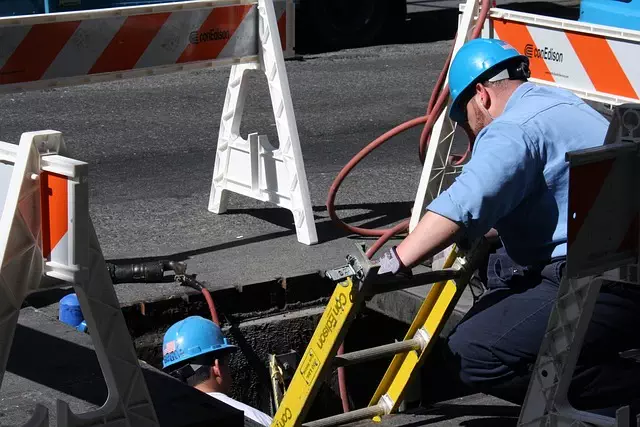Industrial Hygiene is a scientific approach to creating safe work environments by preventing employee illnesses and injuries. Key steps include hazard recognition and assessment, which involves identifying risks like chemical exposure or noise pollution through inspections, reviews, and employee input. Exposure monitoring measures worker interaction with these hazards over time, enabling data-driven decisions for risk mitigation. Training programs should teach employees to recognize, assess, and mitigate risks, focusing on interactive learning methods for better knowledge retention. Regular evaluation and continuous improvement are crucial to adapt to evolving occupational health standards and emerging hazards.
In today’s competitive business landscape, prioritizing employee safety through robust industrial hygiene training is not just a moral imperative but a strategic necessity. This comprehensive guide delves into every critical aspect of program development, from understanding foundational concepts like hazard recognition and assessment to implementing effective exposure monitoring strategies. By mastering these key elements, organizations can create safer work environments, mitigate risks, and foster a culture of proactive health management.
- Understanding Industrial Hygiene: The Foundation of Safe Workplaces
- Hazard Recognition and Assessment: Identifying Potential Risks in the Workplace
- Exposure Monitoring: Measuring and Controlling Employee Hazards
- Developing a Comprehensive Training Program for Industrial Hygiene
- Practical Steps to Implement Training Effectively
- Engaging Employees: Tips for Interactive Learning Experiences
- Continuous Improvement: Evaluating and Updating Your Training Program
Understanding Industrial Hygiene: The Foundation of Safe Workplaces
Industrial Hygiene is a crucial field that focuses on ensuring safe and healthy work environments. It involves the scientific analysis and control of various elements in the workplace, with the primary goal of preventing illnesses and injuries among employees. By understanding industrial hygiene, organizations can create robust training programs that empower workers to recognize potential hazards and manage them effectively. This proactive approach is essential for identifying risks, such as chemical exposure, noise, or ergonomic issues, which could lead to long-term health complications.
Hazard recognition and assessment are key components of this process. It entails identifying and evaluating the presence and severity of any workplace hazard. Exposure monitoring plays a vital role in measuring worker exposure to these hazards over time, allowing for informed decisions to mitigate risks. Through these practices, organizations can foster a culture of safety, ensuring that employees are not only protected but also educated about their rights and responsibilities in maintaining a safe working environment.
Hazard Recognition and Assessment: Identifying Potential Risks in the Workplace
Hazard recognition and assessment are vital steps in developing a comprehensive training program for any industrial setting. It involves identifying potential risks and hazards present in the workplace, which is a crucial aspect of ensuring worker safety and health. By conducting thorough assessments, organizations can uncover various dangers that may go unnoticed, including physical, chemical, biological, or ergonomic factors. This process requires a systematic approach where experts in industrial hygiene play a significant role in evaluating employee exposure to hazardous substances and conditions.
Effective hazard recognition involves regularly inspecting the work environment, reviewing incident reports, and gathering input from workers who spend significant time in specific areas. Once identified, these hazards should be assessed based on their potential severity, likelihood of occurrence, and number of exposed employees. This assessment helps prioritize risks and guides the development of targeted training programs tailored to address each unique challenge, thereby fostering a safer and healthier industrial setting through proactive measures and improved exposure monitoring.
Exposure Monitoring: Measuring and Controlling Employee Hazards
In the realm of training program development, especially within industrial settings, Exposure Monitoring is a cornerstone of effective safety measures. It involves meticulous processes to identify and assess hazards present in the workplace, ensuring employee well-being. This critical aspect of industrial hygiene requires a systematic approach to recognize potential risks and evaluate employee exposure levels to various substances or conditions. By implementing robust exposure monitoring practices, organizations can maintain a safe working environment, adhere to regulatory standards, and foster a culture of proactive safety.
Through thorough hazard recognition and assessment, companies can pinpoint specific dangers within their operations. This includes identifying substances like chemicals, noise, or repetitive motions that may cause harm over time. Once recognized, exposure monitoring involves regular measurements to track the levels of these hazards. By utilizing advanced technologies and methodologies, organizations can control and minimize employee exposure, thereby preventing potential health issues related to industrial activities.
Developing a Comprehensive Training Program for Industrial Hygiene
Developing a comprehensive training program for industrial hygiene involves more than just teaching safety protocols; it’s about empowering employees to recognize, assess, and mitigate risks in their work environment. The process begins with hazard recognition and assessment, where trainees learn to identify potential dangers within their specific industry, from chemical exposure to ergonomic issues. This step is crucial as it equips workers with the knowledge to differentiate between routine tasks and those posing higher health risks.
Once hazards are identified, training should focus on exposure monitoring—measuring and evaluating employee contact with these hazards. This includes teaching techniques for data collection and analysis, enabling staff to track potential health impacts over time. By combining hazard recognition, assessment, and exposure monitoring skills, workers become proactive in maintaining a safe workplace, ensuring that industrial hygiene practices are not just theoretical but actively incorporated into daily operations.
Practical Steps to Implement Training Effectively
Implementing effective training for industrial hygiene programs involves a structured approach to ensure workers are equipped with the knowledge and skills needed to identify, assess, and mitigate hazards in their work environment. Start by conducting a comprehensive needs assessment to gauge existing knowledge levels and identify areas that require targeted instruction. This step is crucial as it forms the foundation for tailored training content, ensuring relevance and impact.
Next, develop engaging training materials that incorporate interactive elements like case studies, demonstrations, and hands-on exercises. Practical scenarios help trainees apply hazard recognition and assessment techniques, fostering a deeper understanding of exposure monitoring methodologies. Regularly update these resources to reflect the latest research and industry standards in industrial hygiene, ensuring ongoing educational value.
Engaging Employees: Tips for Interactive Learning Experiences
Engaging employees is a critical aspect of successful training program development, especially in fields like industrial hygiene where hands-on learning can significantly enhance knowledge retention. Interactive learning experiences not only make training sessions more enjoyable but also ensure that workers actively participate and internalize key concepts, such as hazard recognition and assessment. Incorporating practical activities, case studies, and role-playing exercises allows employees to apply theoretical knowledge to real-world scenarios, fostering a deeper understanding of industrial hygiene principles and exposure monitoring techniques.
To create compelling interactive learning experiences, trainers should leverage a mix of multimedia tools, group discussions, and hands-on demonstrations. For instance, using virtual reality simulations can offer safe, controlled environments where employees can identify potential hazards and practice exposure assessment procedures without risking their safety. Additionally, regular feedback sessions, peer reviews, and Q&A forums encourage active participation, clarify doubts, and promote a culture of continuous learning within the organization, ensuring that industrial hygiene practices remain at the forefront in the workplace.
Continuous Improvement: Evaluating and Updating Your Training Program
Continuous improvement is a cornerstone of any successful training program development strategy, especially in fields like industrial hygiene. Regularly evaluating your program involves assessing its effectiveness, identifying areas for enhancement, and incorporating best practices based on ongoing research and real-world applications. This dynamic approach ensures that your training stays current with evolving occupational health standards and emerging hazards.
For instance, integrating hazard recognition and assessment techniques into your curriculum can empower trainees to identify potential risks in their work environments. Additionally, exposure monitoring methods should be taught to ensure employees understand how to measure and manage exposure to hazardous substances. By fostering a culture of continuous learning, you equip workers with the knowledge and skills needed to maintain a safe and healthy workplace.


